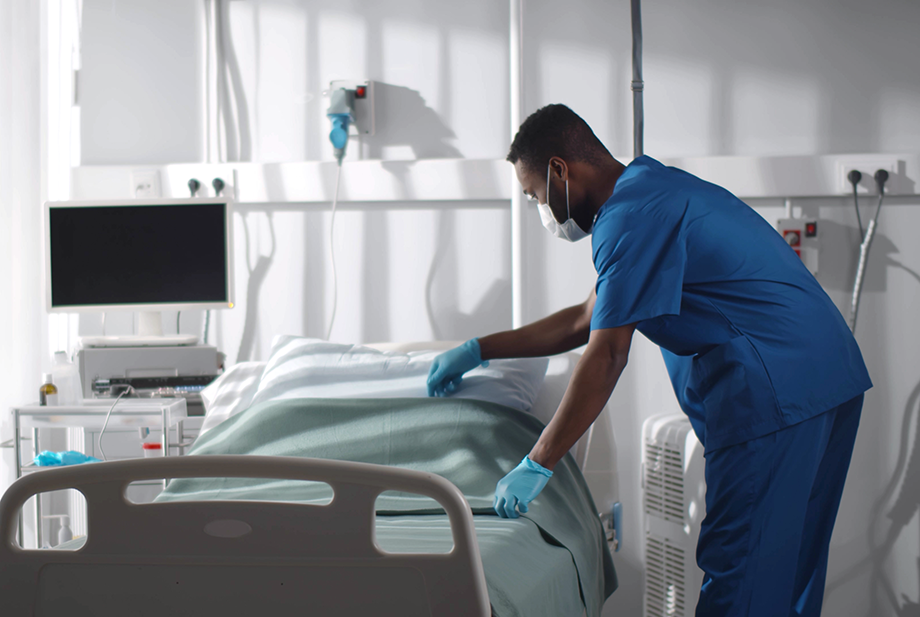Surface Biofilms - An Invisible Enemy
The prevalence of biofilms on hard surfaces and medical equipment in healthcare settings is a serious, yet hidden threat.
Biofilms form a layer of defense for multi-drug resistant organisms (MDROs) and directly contribute to the transmission of healthcare-associated infections (HAIs.)
Biofilm Characteristics
Surface biofilms are becoming increasingly resistant to antibiotics and antimicrobials. When microbes such as bacteria and fungi adhere to a surface, they can form protective biofilms as a barrier against the external environment, including many antimicrobial agents. Moreover, different species often colonize the same biofilm and exchange antibiotic resistant genes, making infections more difficult to treat. The 3 most concerning characteristics of surface biofilms are:
- 65% - 80% of chronic (recurring) infections are related to biofilm.
- Bacteria living in biofilm can exhibit up to 1,000-fold increase in antibiotic resistance.
- Bacteria embedded in biofilms can be 1,500 times less susceptible to disinfectants.

Transmission Risks
Surface biofilms pose significant risks to patients and healthcare workers as they promote the long-term survival of harmful pathogens that can transmit potentially untreatable infections. There are 3 main drivers for biofilm transmission:
- Biofilms are notorious for persisting on plastic, stainless steel, equipment, countertops, walls, and other surfaces as well as on textiles and floors.
- Biofilm formation enables antibiotic and antimicrobial-resistant bacteria and fungi to thrive unchecked for days, weeks, or even months.
- A single touch can transfer biofilm bacteria to healthcare workers’ hands even with gloves, then can transfer to patients and contaminate multiple other surfaces.
Disinfectant Inefficacies
Risks are exacerbated by the fact that most disinfectants cannot penetrate biofilms, let alone inhibit biofilm regrowth. Even if a product does address biofilm, it may be ineffective at killing the primary biofilm-forming MDROs or pose health hazards. Following are 3 examples of research documenting the inefficacy of disinfectants against biofilms.
- Despite two rounds of terminal cleaning with bleach at 10,000 ppm biofilm was not eliminated.
- Studies found biofilms on 93% of ICU surfaces, 52% of which contained MDROs.
- In the presence of soil, hydrogen peroxide had little effect against surface biofilms.
- Quaternary ammonium compounds (QACs) do not meet the EPA standard for bactericidal efficacy against biofilms and have also raised serious health concerns.
Biofilm-Forming Superbugs
The list of microbes, including Gram-positive/Gram-negative bacteria and fungi, that can cling to surfaces and medical devices in biofilms is long and diverse. In addition to other biofilm-forming organisms, all five “superbugs” that contribute to most HAIs can persist in armor-like biofilms.
- Methicillin-resistant Staphylococcus aureus (MRSA)
- Acinetobacter baumannii (A. baumannii)
- Carbapenem-resistant Enterobacteriaceae (CRE)
- Vancomycin-resistant enterococci (VRE)
- Candida auris (C. auris)
- Staphylococcus aureus (S. aureus)
- Klebsiella pneumoniae (K. pneumoniae)
- Pseudomonas aeruginosa (P. aeruginosa)
- Staphylococcus epidermidis (S. epidermidis)
- Escherichia coli (E. coli)
- Clostridioides difficile (C. diff / formerly Clostridium difficile)
Beating Biofilm
Eradicating the MDROs that spread antibiotic-resistant strains through surface biofilms can significantly reduce HAIs. There are 4 key components to biofilm prevention:
- Educate Teams – Train healthcare staff on the dangers of surface biofilms, the organisms they harbor, and the necessity for effective cleaning and disinfection to eradicate them.
- Targeted Protocols – Focus cleaning and disinfection on high-risk surfaces most prone to biofilm formation including reusable and shared equipment.
- Enhanced Measures – Extend range of disinfection efficacy with advanced electrostatic spraying technologies that reach more surface area.
- Efficacy Claims - Use a biocidal agent that has EPA registered efficacy claims against a broad spectrum of bacteria, fungi, and MDROs, plus an EPA registered biofilm kill claim.
NaDCC Chemistry
Training, targeted protocols, and tech enhancements can improve disinfection performance but, chemical selection is critical to mitigating biofilm. Extensive studies have demonstrated the efficacy of a novel NaDCC chemistry against surface biofilm as well as many MDROs.
- Disinfectant testing showed NaDCC was one of the only chemistries able to reduce both direct and cross transmission to prevent biofilm bacteria transfer and recovery.
- According to ASTM E2871, NaDCC in combination with a surfactant improves efficacy against biofilm bacteria as it aids penetration of the protective layer.
- A peer-reviewed paper on the efficacy of disinfectants against C. auris biofilms showed NaDCC achieved a 7-log reduction.
- Data shows NaDCC is a continuously active disinfectant that reduces surface bacteria, including disinfectant resistant C. diff spores, and inhibits biofilm regrowth for 24 hours.
If your disinfectant does not work on biofilm, you're not disinfecting.
Keep surface biofilm at bay and stop HAIs from rising by adding EvaClean’s PurOne NaDCC Cleaner and Disinfectant to your arsenal. It’s one of the most effective weapons available for winning the war on biofilm without any collateral damage to human health.
